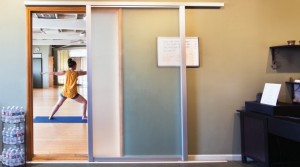 Pocket doors are having a very serious moment right now. I would go so far as to say nearly every potential client that comes to us wanting to build a new home has at least one pocket door on their plan, if not more. What is there not to love? There is no door swinging out into open areas or into a small powder room that you have to squeeze past just to use the restroom. A wall housing a hidden door to separate your more personal rooms from the rest of the home when the time is deemed necessary. That classic feeling when you walk into an older Victorian home and the original pocket doors are remaining that lead into the formal dining room. It does not take much to understand why everyone wants a pocket door in their home.
Pocket doors are having a very serious moment right now. I would go so far as to say nearly every potential client that comes to us wanting to build a new home has at least one pocket door on their plan, if not more. What is there not to love? There is no door swinging out into open areas or into a small powder room that you have to squeeze past just to use the restroom. A wall housing a hidden door to separate your more personal rooms from the rest of the home when the time is deemed necessary. That classic feeling when you walk into an older Victorian home and the original pocket doors are remaining that lead into the formal dining room. It does not take much to understand why everyone wants a pocket door in their home.
All of this is fine and dandy for a new construction home, but how exactly does this work for a remodel? You could look up the answer to this question but let me help you out here. Its hard! In a new construction home, the pocket door is put in place at the time of framing. This is before any dry wall hits the scene. When adding a pocket door to a remodeling job, it requires the removal drywall, cutting a hole to access the studs, removing the studs, rerouting electrical wires, and so much more. Hopefully you’re catching my drift here.
So to answer the initial question, I offer a solution: sliding interior doors. More specifically, sliding interior doors that mount to a barn door track. These styles of doors offer the same functionality as a pocket door without anyone having to cut into any walls. There are no swinging doors in anyone’s way and they slide back and forth just as a pocket door would.
Not only do sliding interior doors compare nicely to pocket doors, they also have one great advantage to them. As stated before, pocket doors are put on site very early in construction. This often leads to mishaps throughout the building process due to a long list of things. Have you ever been on a job site? Things tend to get pretty messy. The inter-workings of your walls include things such as plumbing lines and electrical lines, not to mention all the hammering that takes place. It does not take much to destroy a pocket door kit.
Sliding interior doors are installed after the time of construction, especially in a remodeling job. This is one of the great benefits to sliding interior doors because you have many fewer things to worry about when it comes to ensuring the quality of your door. You simply have to install the door, and enjoy.
Pocket doors and sliding interior doors each have their advantages inside the home. If you are building a home from start to finish, a pocket door can work for you. I would still considering weighing the pros and cons when it comes to the quality you want in the end. If you are working on remodeling and home and want to achieve the classic pocket door style, interior sliding doors are perfect for your home.
